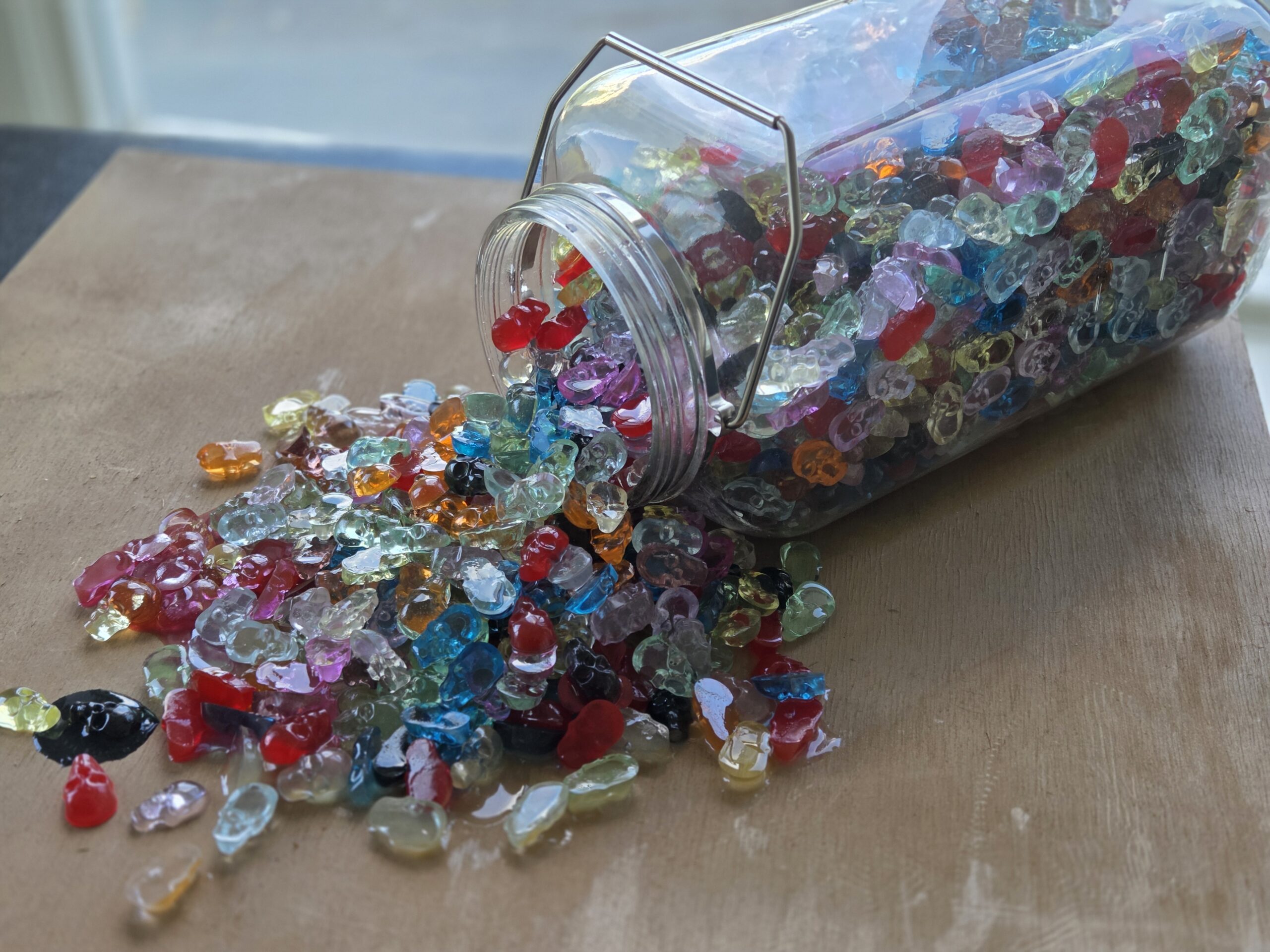
Art, empathy, and the LGBTQIA+ community
by Kurt White // October 30, 2025
Published in the Brattleboro Reformer on October 9, 2025.
For therapist and artist Steve Prentice, creativity isn’t just expression — it’s survival. His latest art piece confronts a devastating reality: the staggering number of LGBTQIA+ youth who consider suicide each day. Using nearly two thousand small, colorful elements, Steve transforms statistics into something heartbreakingly tangible — a visual call for empathy, awareness, and change. In this conversation with Kurt White, vice president of Community Partnerships/Communications at the Brattleboro Retreat, Steve reflects on the inspiration behind his work, the intersection of art and healing, and how small acts of understanding can make a life-saving difference.
Kurt: Tell us about yourself and how your varying talents as an artist, creative person, and therapist have come together in this and other projects.
Steve: For me, art has always been how I process the work I do. It’s so intense. I’ve been an artist my whole life, but I got serious about it after I started working in mental health. It’s my way of processing the things I see every day and trying to make sense of it. It gives me space to do that and, strangely, to escape it at the same time. This is especially true for projects like this, where the numbers are just so huge. Reducing a huge issue to a project helps me conceptualize what it truly means.
Kurt: The issue you’re addressing is suicide and suicidal ideation in the LGBTQIA+ community. Is this a special interest of yours or one you see frequently in your clinical work?
Steve: It’s both. I’ve been involved in the community for about 40 years, doing various levels of advocacy work. It’s also personal. I had a friend who died by suicide shortly after high school because his family and religious community couldn’t support him in the way he needed. It just became too much. So, it’s both professional and personal.
Kurt: The numbers you’re talking about are the disproportionate burden affecting folks in this group, especially young people. LGBTQIA+ youth who lack the support they need and face discrimination are at four times the risk of suicide as the general youth population. Is that right?
Steve: Yes, that’s exactly right. When they face discrimination at home, in housing, in their community — when they get bullied — it disproportionately increases the risk. That minority stress is just too much. When you also have young people who are part of other minority groups — ethnic, religious, or racial minorities — those factors compound on each other.
I think one of the big things that’s important to understand is that this has nothing to do with the child’s orientation. This is not because somebody has a certain sexual orientation. It’s because they face these discriminations and barriers in their communities, and that is what puts them at higher risk.
Kurt: That’s a finding about suicide that goes back to Emile Durkheim, isn’t it? When people don’t have supportive structures in the larger society, they are more at risk. Can you say more about that sense of alienation or discrimination? Do you have concrete numbers about that?
Steve: Absolutely, I brought some numbers: 24 percent of LGBTQIA+ youth have reported being physically threatened in the past year; 52 percent of kids in middle and high school have been bullied because of their sexual orientation; and over 60 percent have faced some type of discrimination in the past year. That’s a pretty chilling set of numbers. When you think that any child who faces multiple of those barriers is four times higher risk for suicide, it’s very sobering.
Kurt: Tell us about this piece of artwork and how you came to envision and create it.
Steve: It’s one of those subjects that’s always on my mind, especially with the clients I work with and the things they face. I often back my way into these projects by first looking at the statistics. When I looked at the yearly number for this issue, it was so huge — in the millions — I thought, How do I possibly represent that in a physical form?
I had to break it all the way down to a daily number before it was something I could actually represent in art. Then the process started: How do I do that? That’s when I jumped online and came across the little candy skulls. I decided I wanted to use the rainbow colors, and then it became a whole process of figuring out the best way to present it visually. I had to break it all the way down to a day to get to a point I could manage.
Kurt: And there really are 1,953 pieces in the artwork?
Steve: Yes, there are exactly 1,953 pieces. One for each child who seriously considers suicide every day. That’s literally one every 45 seconds, which was the number that just blew me away when I did the math.
Kurt: Sometimes a problem can get so large that people become statistics, and then it’s even harder to think about. We appreciate the visual element that concretizes it and makes it visible in a different way. Are there particular feelings you hope are evoked by this piece?
Steve: I hope it raises awareness of how important empathy is, and that even small gestures can make such a big difference. On the other side, I hope people who are struggling see that somebody sees them and hears them — that, Yes, I know you’re hurting.
There’s a quote that inspires a lot of my political work: “Art’s purpose is to comfort the disturbed and disturb the comfortable.” When people say the piece is disturbing, I say, “That’s good. I want you to be disturbed.” But I’ve also had people feel seen and inspired by my work to create their own art to address the traumas they face. If a piece can do that, it’s successful.
Kurt: Speaking as a therapist, is there a message of hope you might want to convey to folks who find themselves isolated and struggling?
Steve: The truth is, there are people out there who see you and we care. We want you to know that you are okay exactly the way you are. That’s an important message to put out there as often as possible.
Kurt: Is there anything I didn’t ask you that you wanted to make sure to say?
Steve: Just going back to what people can take from it: it doesn’t take a lot to make a huge difference. It takes one adult who shows they care and that this kid matters to cut their risk of suicide in half. A supportive family, community, or school — if you can be any part of those things, you can change a kid’s life.
Kurt: What would support mean concretely? What would you have someone do?
Steve: Big ones are things like supportive pronouns. That’s a really big, important one right now. Also, telling kids out loud that they are okay exactly the way they are. They’re not broken, and they are loved.
A little sign or a little flag may seem silly to someone not in the community, but it really is a signal to people who are in the community that this is a safe place for them.
Kurt: Does the piece have a title?
Steve: It does not. A lot of times, I don’t title these pieces. I don’t want to put too much on it and take away the experience for people.




